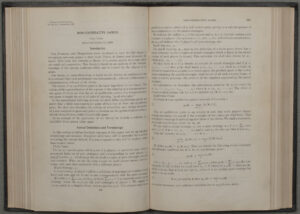Published: Princeton, N.J., 1951
Over the past 60 years, game theory has been one of the most influential theories in the social sciences, pervasive in economics, political science, business administration, and military strategy – the disciplines most consulted by the powers-that-be for “real-world,” high-stakes decisions. But just as there would be no semiconductors or (God forbid) laser pointers if not for the abstruse mathematics of quantum theory, game theory can be traced back to theoretical work by academic mathematicians. In a set of papers in the 1950s, mathematician John Forbes Nash set forth breakthrough ideas that helped transform game theory from an ivory tower abstraction into an indispensable analytical tool used by strategists from Wall Street to the Pentagon.
The foundational game theory work of mathematician John von Neumann and economist Oskar Morgenstern, published in 1944, provided a framework for solutions to zero-sum games, where one player’s win was the other’s loss. Nash, in his dissertation research at Princeton (published in this and three other papers), extended game theory to n-person games in which more than one party can gain, a better reflection of practical situations. Nash demonstrated that “a finite non-cooperative game always has at least one equilibrium point” or stable solution. This result came to be called the “Nash equilibrium,” a situation where no one player can get a better payoff by changing strategies, so long as other players also keep their strategies. Using Nash’s framework, predictions can be made about the outcomes of strategic interactions.
Based on Nash’s advances, game theory developed into one of the pre-eminent tools of economics in the second half of the 20th century. In recognition of his breakthrough work, Nash was joint recipient of the Nobel Prize for Economics in 1994 for “pioneering analysis of equilibria in the theory of non-cooperative games.”
If visions of Russell Crowe have danced in your head while you’ve been reading this post, that’s probably because you remember that Crowe played John Forbes Nash in the 2001 film A Beautiful Mind (at least we hope that’s why). Part of the movie takes place at MIT, portraying Nash’s years as an instructor in mathematics at the Institute, where he worked from 1951 to 1959, until mental illness curtailed his mathematical career.
